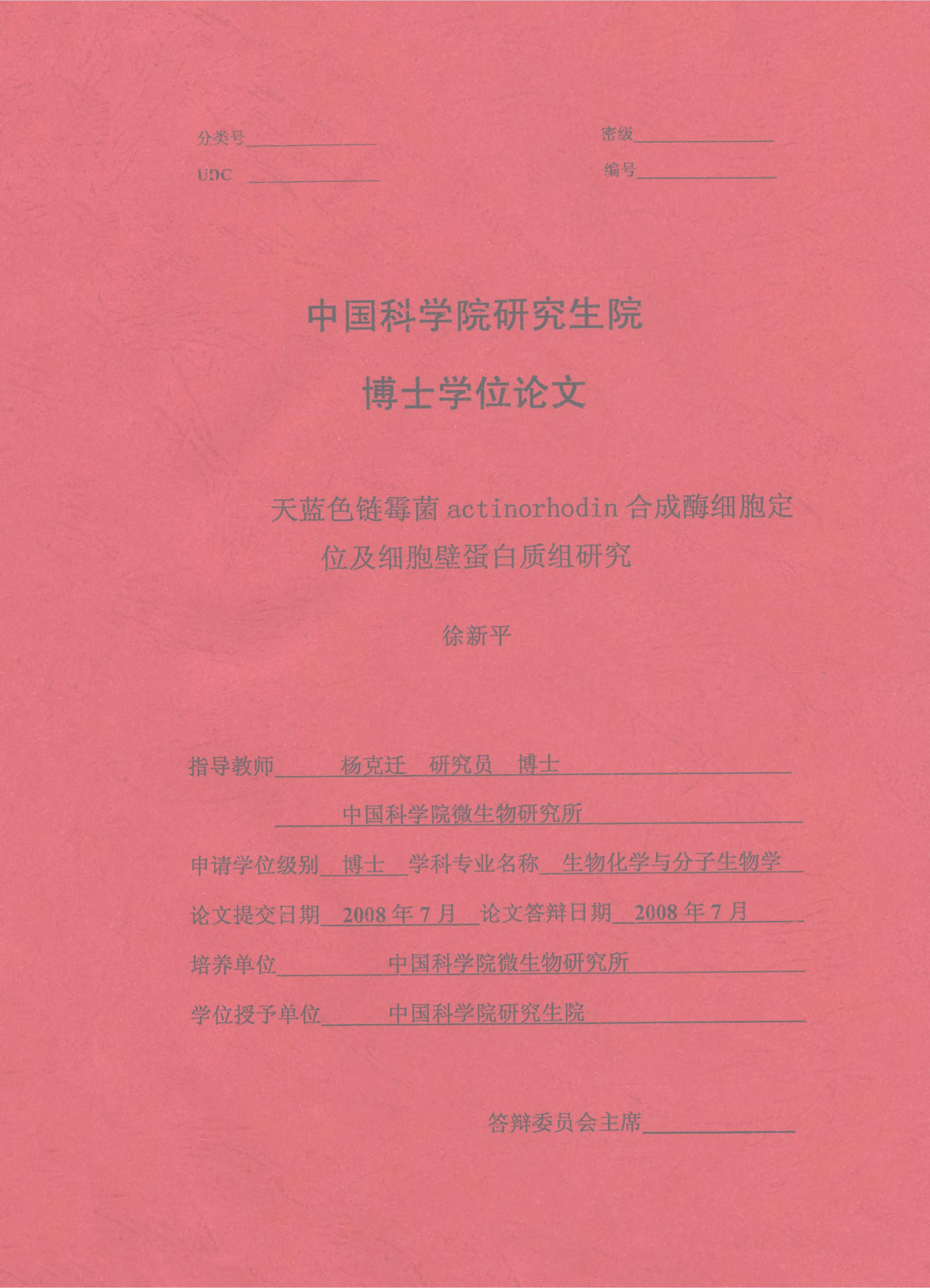
放线紫红素(actinorhodin,Act)是由天蓝色链霉菌(Streptomyces coeBcobr)产生的Ⅱ型聚酮化合物。Ⅱ型聚酮化合物碳链合成由最小聚酮合酶(minimal polyketide synthase,PKS)催化,它包括合酶α和β亚基(KSα和KSβ),酰基载体蛋白(acyl carrier protein,ACP)及与脂肪酸合成共用的马龙酰辅酶A转移酶(malonyl CoA transferase,MAT)。聚酮链的后修饰经常由酮基还原酶(ketoreductase),环化脱水酶(cyclase/dehydrase),氧化还原酶(oxygenases)等后修饰酶催化。Ⅱ型聚酮合酶的前期研究结果表明,参与Ⅱ型聚酮化合物合成的各个酶之间存在蛋白质之间的相互作用。本论文试图分离并鉴定Ⅱ型聚酮合酶及后修饰酶复合物。 首先在大肠杆菌中超表达了聚酮合成途径的几个蛋白KSα(ActⅠ-ORF1)、 KSβ(ActⅠ-ORF2),ACP(ActⅠ-ORF3)和KR(ActⅢ),制备纯化的蛋白,用来免疫兔子制备抗体,纯化抗体并验证效价。这些抗体为进一步纯化聚酮合酶复合物提供了检测手段。 将纯化的Anti-KR抗体交联到AP-Formyl 650M介质,针对天蓝色链霉菌无细胞抽提液进行免疫共沉淀实验,得到多个可能与Anti-KR抗体作用的蛋白,但是经Western和质谱鉴定证明部分蛋白可能为假阳性。 用超速离心的方法获得胞质蛋白和细胞膜沉淀,胞膜沉淀变性溶解后直接用SDS-PAGE分离,可检测到KSα和KR信号,在胞质蛋白中仅检测到微弱的KSα信号,但检测不到KR信号。胞膜用表面活性剂溶膜后,进行BN/SDS-PAGE二维电泳后,检测到微弱的KSα信号,说明溶膜的效果不好。超离心得到膜蛋白的二维电泳有横纹现象,对四个主要横纹蛋白用MALDI-TOF/TOF鉴定,发现它们对应四个多重跨膜运输蛋白。采用直接在低速离心上清总蛋白中加表面活性剂方法溶膜,用二维BN/SDS-PAGE电泳分离,可以得到一个小的复合物,Western可以检测到KSα和Ksβ信号,但检测不到KR信号。该总蛋白溶膜样品,用分子筛分离,也得到一个分子量在66-100 kD的复合物,在同一个洗脱馏分中可以用Western检测到KSα和Ksβ信号。而低速离心上清总蛋白用蔗糖密度梯度离心分级后,在上清中检测到KSα和KSβ信号,在沉淀中检测到KR信号。以上结果均表明,KSα和KSβ形成一个膜复合物,而KR可能不在膜组分里。 为了确定KR的细胞定位。使用4%SDS煮沸的方法获得细胞壁样品,用超声随机释放或用溶菌酶及lysostaphin消化释放与细胞壁结合的蛋白,再用Western检测KSα和KR。在随机或溶菌酶释放的蛋白中可以检测到KR信号但检测不到KSα信号。完整菌体用溶菌酶消化也可以在培养液上清中检测到KR,而对照细胞不经溶菌酶处理则检测不到KR。用免疫荧光技术对KR进行定位,可以在野生型细胞表面观察到荧光,而被溶菌酶消化的细胞(原生质体)看不到荧光信号,Act基因簇缺失的突变株表面也看不到荧光。这些证据充分证明, KR是与细胞壁结合的。 为了进一步确认参与Act合成酶的亚细胞定位,对天蓝色链霉菌细胞壁蛋白质组进行了研究。通过一维SDS-PAGE电泳结合液质联用蛋白质鉴定技术对获得的细胞壁总蛋白进行鉴定分析,共鉴别了182个蛋白。结果证实KR在细胞壁蛋白组中存在,同时还发现Act合成途径的其它5个后修饰酶。此外,还在细胞壁蛋白组中发现了Ⅰ型聚酮合酶和其它可能参与次级代谢的酶。让人意外但和其它微生物壁蛋白组结果类似的是,本研究检测到多个预测的胞质蛋白或膜蛋白:它们包括多个核糖体亚基、多个ATP酶亚基、应激蛋白、运输蛋白及参与细胞初级代谢,如糖酵解和三羧酸循环的蛋白及一些功能未知的蛋白等。在壁蛋白组中也检测出已知的细胞壁蛋白。本文是链霉菌细胞壁蛋白质组研究的首次报道,必将对相关研究产生深远的影响。 关键词:天蓝色链霉菌(Streptomyces coelicolor),聚酮合酶,酮基还原酶(ketoreductase,KR),细胞壁,蛋白质组学,BN/SDS-PAGE,免疫荧光技术。
Actinorhodin (Act) is a type Ⅱ aromatic polyketide produced by Streptomyces coelicolor. The carbon chain of type Ⅱ polyketide are synthesized by minimal polyketide synthases (PKSs), consisting of ketosynthase/chain length factor (KS/CLF, also known as ketosynthase a subunit (KSα) and β subunit (KSβ)), acyl carrier protein (ACP) and fatty acid synthase malonyl CoA: ACP transacylase (MAT). The polyketide chains are modified by additional tailoring enzymes, such as ketoreductase (KR), cyclase/dehydrases and oxygenases to generate the final structure. The goal of my research is to isolate and characterize the PKS and tailoring enzyme complexes of actinorhodin biosynthesis. To prepare antibodies specific for actinorhodin biosynthetic enzymes, several enzymes of the Act biosynthetic pathway, KSα, KSβ, ACP and KR, were overexpressed as GST fusion proteins in E. coli by using pGEX-6p-1, and the expressed proteins were purified by GST affinity chromatography. The purified proteins were injected into rabbits to raise antisera, and Anti- KSα and Anti-KR antibodies were purified. Cytoplasmic proteins and membrane proteins were prepared by ultracentrifugation, the precipitated membrane proteins were boiled in SDS and separated on SDS-PAGE, KSα and KR were detected in the membrane samples; KSα was also weakly detected in cytoplasmic sample. The precipitated membrane proteins were dissolved using different detergents and analyzed on BN/SDS-PAGE, the detection of KSα became weak indicating protein solubilization was poor. Putative membrane complexes dissociated during SDS-PAGE and formed horizontal streaking bands. 4 predominant bands were excised and analyzed by MALDI-TOF/TOF, they represent cross membrane transport proteins. To improve membrane protein solubilization, total cellular proteins were dissolved using detergents, the solution containing membrane proteins were analyzed BN/SDS-PAGE, a small complex containing KSα and KSβ was detected. The total proteins with dissolved membrane proteins were purified on size exclusion column, a fraction containing both KSα and KSβ was obtained. Total cellular proteins were also fractionated by sucrose gradient centrifugation, KSα and KSβ were detected in a solution fraction while KR was detected in the precipitation fraction. Above results suggest that KSα and KSβ form a membrane associated complex, but KR is not present in the cytoplasm or in the membrane. To determine the cellular location of KR, cell wall subproteome was prepared using the 4% SDS boiling method, proteins in the cell wall sample was released randomly by sonication or enzymatically by lysozyme or lysostaphin treatment. KR was detected in samples of randomly released or lysozyme released proteins, KSα was not detected. Then mycelia of S. coelicolor were incubated with or without lysozyme, culture supemants were separated on SDS-PAGE, and examined by Western blotting, KR was only detected in the lysozyme treated culture supernatant. Immunofluorescence experiments also detected KR on the surface of S. coelicolor mycelia but not on that of S. coelicolor YU105 mutant in which the Act gene cluster was deleted. These results suggest KR is located on the cell wall. To confirm the cell wall location of KR and to examine the locations of other tailoring enzymes in Act biosynthesis, we studied the cell wall subproteome by combination of SDS-PAGE with LC/MS and identified 182 proteins. Among these proteins, we found KR and five other proteins in Act pathway, and also a type Ⅰ PKS and several other enzymes involved in secondary metabolism. Surprisingly, but consistent with results from other cell wall proteome studies, we identified large numbers of cytoplasmic and membrane proteins, these include ribosomal subunits, ATPase subunits, stress response proteins, transport proteins and those involved in glycolysis and TCA cycle and some unknown proteins.. Several predicted cell wall proteins were also identified. This is the first report of cell wall proteome study on S. coelicolor. Keywords: Streptomyces coelicolor, polyketide synthase (PKS), protein localization, ketoreductase (KR), cell wall, proteome, BN/SDS-PAGE, immunofluorescence.